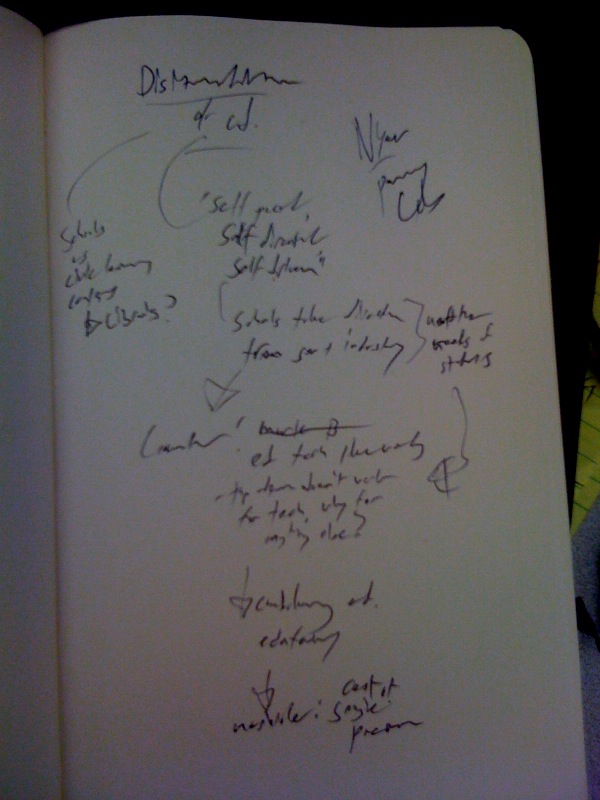A lot of things have been knotting themselves together in my head, especially the issue of being able to justify what I do with my life, I feel like pseudo-techno-metrics are creeping in.
In a post about disintermediation in “education 2.0”, Rob Tucker begins with the idea that the design of technologies often happen to us, and that the disintermediation of educators from those being educated will increase, much like it did in the travel and bookselling businesses. He proposes that “(i)f we take the primary function of school to be the dissemination of knowledge, the disintermediation could be near total,” as in his mind, educators, the as “middle-men” of education take away resources from the value of the educational experience. This seems like an over-simplification of what education is. If this were “The Matrix,” his point makes sense, but there are many other reasons why we have educators aside from functioning as funnels for “knowledge” that society uses to dump stuff into people’s heads.
It’s not all bad, really. Tucker supposes that students will be “self-paced, self-directed, self-driven.” Since there still might need to be physical places, “schools will evolve into things that look more like civic centers – hubs for community involvement and rich relationship-building, augmented by more spontaneous micro-communities that span the globe, forming and bursting like soap bubbles.” This sounds like a library, but is that really a good format for schools? First of all, that’s a lot of “self” and part of education is learning about things outside of one’s own self, or at least learn how to play well with others. While he gives some primacy for relationship building, if you are relentlessly pursuing your own course, guided by AI-driven “counselors,” do you really build relationships, or do you treat others like some kind of capital investment, which you will let go of once they no longer meet your need?
The businessification of education echos the increasing role of metrics in our work and daily lives: we are all supposed to be measurable. Whereas Ester Duflo’s Poverty Action Lab recognizes the limits of measurement (specifically in using it to manage complex decisions) when it comes to people, Tucker clearly does not. The impulse being followed is that adding another person to a “value-chain” is a drain, assuming that educators add no value that cannot be embedded into some kind of automated courseware. A couple of days later, another O’Reilly blogger, Marie Bjerede wrote an entire post pointing out that “the designers can accurately predict what users will need in perpetuity and develop a static one-size-fits-all product.” Disintermediated education is a one-size-fits all concept and the idea that educators do not add value is a cost-cutting wet-dream. Education is not the grocery store checkout line or a travel agency. Knowledge is a complex thing, as is its’ transmission, and educators facilitate the learning process in a less than “one-size-fits-all” way. Tucker thinks that a business model fits completely as an educational model.
 The mistaken idea that you can make education a business is chronic, and given the collapse of the University of California system, it’s getting to the red line rather quickly. In a series of posts at Art21, independent “anti-authoritarian scholar” (an oxymoron?) Marc Herbst leans into this idea pretty hard:
The mistaken idea that you can make education a business is chronic, and given the collapse of the University of California system, it’s getting to the red line rather quickly. In a series of posts at Art21, independent “anti-authoritarian scholar” (an oxymoron?) Marc Herbst leans into this idea pretty hard:
“Theoretically, the movements are concurrent with the critical clarifications of immaterial labor; witness how universities change policies to better commodify thought-work while streamlining and uncritically redefining education. Folks like Gigi Rogero and websites like edufactory have been creating critical theory around this phenomenon of this neoliberalization of education.”
All of this came back to mind when I saw this little post from Mashable citing that Google’s Pac-Man logo cost society (businesses, etc.) 4,819,352 hours of time, or $120,483,800 in productivity. This according to people whose business it is to monitor people and deliver optimum human capital. This they called a “tragedy“: employees spent 36 seconds on average messing with the thing. If this isn’t a prime example goofy techno-metrics and business-think overkill, I’m not sure what is. Maybe the answer is to provide students and people with meaningful and important work, and the metrics will help measure their success.

A physics grad student was having trouble measuring the performance of his experiment in the lab one day, when a Nobel prize winning physicist walked in and asked what the problem was. The grad student explained the issue, and afterward the physicist imparted some advice on him. Upon taking the advice, the grad student found a solution to the problem, and published a paper on it. His technique for measuring his system performance is pretty much standard for researchers in similar fields. What highly technical advice did the Nobel prize winning physicist give the grad student? “I would go for a bike ride if I were you.”
I think your last paragraph sums up a common and foolish way of thinking. Time not spent “working/learning” (whatever vague meaning those words have) is time wasted. That’s pretty much a recipe for a society without creativity. Creativity is a necessity for real innovation.
and then there’s this!
http://www.monkproject.org/
also:
http://www.npr.org/templates/story/story.php?storyId=128362511&sc=fb&cc=fp